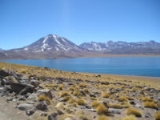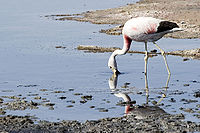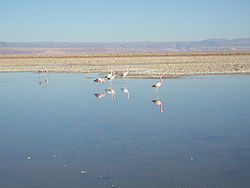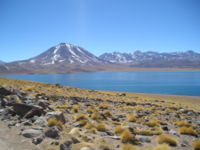
Los Flamencos National Reserve
Encyclopedia



Nature reserve
A nature reserve is a protected area of importance for wildlife, flora, fauna or features of geological or other special interest, which is reserved and managed for conservation and to provide special opportunities for study or research...
located in the commune of San Pedro de Atacama, Antofagasta Region
Antofagasta Region
The II Antofagasta Region is one of Chile's fifteen first-order administrative divisions. It comprises three provinces, Antofagasta, El Loa and Tocopilla...
of Chile
Chile
Chile ,officially the Republic of Chile , is a country in South America occupying a long, narrow coastal strip between the Andes mountains to the east and the Pacific Ocean to the west. It borders Peru to the north, Bolivia to the northeast, Argentina to the east, and the Drake Passage in the far...
. The reserve covers a total area of 740 square kilometres (182,857.8 acre) in the Central Andean dry puna
Central Andean dry puna
The Central Andean dry puna is an ecoregion, in the Montane grasslands and shrublands biome, located in the Andean High plateau, in South America...
ecoregion
Ecoregion
An ecoregion , sometimes called a bioregion, is an ecologically and geographically defined area that is smaller than an ecozone and larger than an ecosystem. Ecoregions cover relatively large areas of land or water, and contain characteristic, geographically distinct assemblages of natural...
and consists of seven separate sectors.
Salar de Tara-Salar de Aguas Calientes
This area is made up of two Salt flats: Tara at 23°05′S 67°15′W and Aguas Calientes at 23°07′S 67°25′W.In 1996, Salar de Tara was designated a Wetland of International Importance
Ramsar list of wetlands of international importance
This is the list of wetlands of international importance as defined by the Ramsar Convention for the conservation and sustainable utilization of wetlands, recognizing the fundamental ecological functions of wetlands and their economic, cultural, scientific, and recreational value.The Convention...
by the Ramsar Convention
Ramsar Convention
The Ramsar Convention is an international treaty for the conservation and sustainable utilization of wetlands, i.e., to stem the progressive encroachment on and loss of wetlands now and in the future, recognizing the fundamental ecological functions of wetlands and their economic, cultural,...
. It features permanent and seasonal lakes. Among them the main one is Tara Lake, which is fed by the Zapaleri River.
Salar de Tara provides habitat for various rare and endangered species
Endangered species
An endangered species is a population of organisms which is at risk of becoming extinct because it is either few in numbers, or threatened by changing environmental or predation parameters...
of wildlife. Mountain viscacha, Vicuña
Vicuña
The vicuña or vicugna is one of two wild South American camelids, along with the guanaco, which live in the high alpine areas of the Andes. It is a relative of the llama, and is now believed to share a wild ancestor with domesticated alpacas, which are raised for their fibre...
, and Darwin's Rhea
Darwin's Rhea
Darwin's Rhea, Rhea pennata, also known as the Lesser Rhea, is a large flightless bird, but the smaller of the two extant species of rheas. It is found in the Altiplano and Patagonia in South America.-Description:...
are endangered species. Others, such as Andean Goose
Andean Goose
The Andean Goose, Chloephaga melanoptera, is a member of the duck, goose and swan family Anatidae. It is in the shelduck subfamily Tadorninae.It is resident around lakes and marshes in the high Andes, usually well above 3000 m...
, Horned Coot
Horned Coot
The Horned Coot is a species of bird found at lakes in the altiplano of north-western Argentina, south-western Bolivia, and north-eastern Chile. It is almost entirely restricted to altitudes of 3000-5200 m.a.s.l., but has occasionally been recorded at lower altitudes...
, Andean Gull
Andean Gull
The Andean Gull is a species of gull in the Laridae family. As is the case with many gulls, it has traditionally been placed in the genus Larus.It is found in Argentina, Bolivia, Chile, Colombia, Ecuador, and Peru....
, Puna Tinamou
Puna Tinamou
The Puna Tinamou, Tinamotis pentlandii also known as Pentland’s Tinamou is a member of the most ancient groups of bird families, the tinamous. This species is native to southern South America.-Taxonomy:...
and the three flamingo species inhabiting in Chile, are considered vulnerable. Conservation status
Conservation status
The conservation status of a group of organisms indicates whether the group is still extant and how likely the group is to become extinct in the near future...
of Tawny Tuco-tuco
Tawny Tuco-tuco
The Tawny Tuco-tuco is a species of rodent in the family Ctenomyidae.It is found in Argentina and Chile....
and Culpeo
Culpeo
The culpeo , sometimes known as the culpeo zorro or Andean fox , is a South American species of wild dog. It is the second largest native canid on the continent after the maned wolf. In its appearance it bears many similarities to the widely recognized red fox...
fox is unknown.
Salar de Pujsa
Salar de Pujsa is a salt flat located at 23°12′S 67°32′W and northeast of AcamarachiAcamarachi
Acamarachi, also known as Pili, is a stratovolcano located northeast of the volcanoes Aguas Calientes and Lascar, and southwest of the sector Salar de Pujsa of Los Flamencos National Reserve, in the Antofagasta Region of Chile. The volcano lies on a high plateau called Puna de Atacama.It has a...
volcano.
Lagunas Miscanti y Miñiques
This area comprises the lagoons Miscanti at 23°43′S 67°46′W and Miñiques at 23°46′S 67°47′W situated at the foothills of Cerro MiscantiCerro Miscanti
Cerro Miscanti is a mountain located in the Antofagasta Region of Chile, immediately south of Chiliques and north of Miñiques. It towers over Laguna Miscanti.-See also:* Miñiques* Chiliques* Laguna Miscanti* Cordón Puntas Negras...
and the volcano Miñiques
Miñiques
Miñiques is a massive volcanic complex containing a large number of craters, lava domes and flows, located in the Antofagasta Region of Chile. Located south of Volcán Chiliques and west of Cordón Puntas Negras, it is part of a frequently visited attraction conformed by the high plain lagoons...
.
This portion of the reserve is home to a variety of birds, including Andean Flamingo
Andean Flamingo
The Andean flamingo, or Phoenicopterus andinus, is one of the rarest flamingos in the world. It has a pale pink body with brighter upperparts, deep vinaceous-pink lower neck, breast, and wing-coverts. It is the only flamingo species with yellow legs and three-toed feet. The bill of the Andean...
, Chilean Flamingo
Chilean Flamingo
The Chilean Flamingo is a large species closely related to Caribbean Flamingo and Greater Flamingo, with which it was sometimes considered conspecific...
, Horned Coot, Silvery Grebe
Silvery Grebe
The Silvery Grebe is a species of grebe in the Podicipedidae family.It is found in Argentina, Chile, the Falkland Islands and Paraguay as well as Andean regions of Bolivia, Colombia, Ecuador and Peru. It is a vagrant to Brazil....
, Andean Gull and Greenish Yellow Finch.
Salar de Atacama (sector Soncor)
In this area is located Chaxa Lagoon at 23°19′S 68°10′W, within the Salar de AtacamaSalar de Atacama
Salar de Atacama is the largest salt flat in Chile. It is located south of San Pedro de Atacama, is surrounded by mountains and has no drainage outlets. To the east is enclosed by the main chain of the Andes, while to the west lies a secondary mountain range of the Andes called Cordillera de Domeyko...
.
Chaxa Lagoon provides habitat for bird species. Among those are Chilean and Andean Flamingos, Andean Avocet
Andean Avocet
The Andean Avocet is a large wader in the avocet and stilt bird family, Recurvirostridae. It is resident in the Andes, breeding above 3500 m in northwestern Argentina, western Bolivia, northern Chile and southern Peru.-Description:...
, Speckled Teal
Speckled Teal
The Yellow-billed Teal is a South American species of duck. Like other teals, it belongs to the diverse genus Anas; more precisely it is one of the "true" teals of subgenus Nettion. It occurs in Argentina, the Falkland Islands, Chile, Peru, Bolivia, Uruguay, and Brazil...
, Crested Duck
Crested Duck
The Crested Duck is a species of duck native to South America, the only member of the monotypic genus Lophonetta. It is sometimes included in Anas, but it belongs to a South American clade that diverged early in dabbling duck evolution . There are two subspecies: L...
, Puna Plover
Puna Plover
The Puna Plover is a species of bird in the Charadriidae family.It is found in Argentina, Bolivia, Chile, and Peru.Its natural habitats are freshwater lakes and saline marshes.-References:...
, and Baird's Sandpiper
Baird's Sandpiper
The Baird's Sandpiper is a small shorebird. It is among those calidrids sometimes separated in Erolia.Adults have black legs and a short thin dark bill. They are dark brown on top and mainly white underneath with a black patch on the rump. The head and breast are light brown with dark streaks. In...
.
Sistema hidrológico de Soncor (Soncor's hydrological system), like Salar de Tara, is a Ramsar site. It comprises four shallow salt lake
Salt lake
A salt lake or saline lake is a landlocked body of water which has a concentration of salts and other dissolved minerals significantly higher than most lakes . In some cases, salt lakes have a higher concentration of salt than sea water, but such lakes would also be termed hypersaline lakes...
s.
Valle de la Luna
_chile_luca_galuzzi_2006.jpg)

